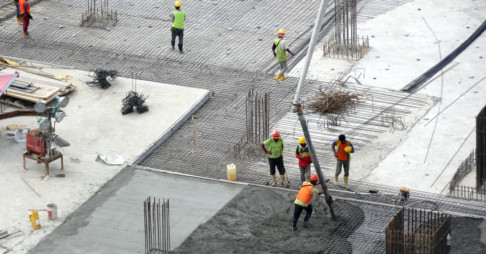As buyers in the voluntary carbon market continue to feel uneasy about the integrity of some carbon credits, they are increasingly turning to credits that are issued by third-party registries.
Third-party certification ensures that carbon credits are validated and verified by a trustworthy entity outside of the project developer. This includes proving how the carbon removal or reduction is measured, along with a number of other criteria that impact the quality of the carbon credits, based on a registry standard.
In this article, we’ll look specifically at Verra’s Verified Carbon Standard, under which CarbonCure Technologies’ methodology for carbon mineralization in concrete has been validated and our carbon credits are being verified.
- Who verifies carbon credits?
- How are carbon credits verified?
- What does VCS mean?
- What does VCU mean?
- What is a VCU price?
- What does MRV mean?

VOLUNTARY CARBON MARKET
Who verifies carbon credits?
Carbon credits are typically verified by independent, non-profit organizations that are committed to making sure carbon removal projects are measuring CO2 reduction and removal as accurately as possible. Verra is an example of such an organization.
These organizations are often called standards, because they create the rules and criteria that carbon removal and reduction projects must meet in order to issue verified carbon credits. They review and ultimately approve the methodologies for measuring the reduction of greenhouse gasses (GHGs) and perform additional validation and verification of carbon credits.
Standards also operate registries to ensure each verified carbon credit is uniquely numbered and tracked from the time it is generated, through sale and use as an offset. The records of issuance and retirement are visible to the public on their registries.
How are carbon credits verified?
Validation and verification bodies (VVBs) work closely with registries like Verra and play a key role in ensuring the integrity of carbon credits. VVBs are independent, third-party engineers and scientists accredited by the standard. They vet the documentation for carbon-removal projects to ensure its design follows the approved methodologies. Once a project is up and running, VVBs conduct regular audits to ensure the accuracy of data and reporting. In short, they make sure that both the project itself and every step taken to generate the carbon credits is meeting the standard’s criteria.
As the name of validation and verification bodies (VVBs) implies, there are two steps: project validation and carbon credit verification.
- Project validation. VVBs will first validate a carbon removal or reduction project. A key component of validation is reviewing and approving the project’s methodology for measuring the CO2 removal and/or reduction.
Project validation also includes ensuring the CO2 removal/reduction:
- is additional (that is, it wouldn’t be achieved without the revenue from carbon credits)
- doesn’t create other unintended negative environmental or social impacts
- accounts for potential leakage (any temporary displacement of emissions) and
- assesses the risk of reversal also called the durability or permanence of the carbon storage.
- Carbon credit verification. Once a project is validated, the carbon credits it generates can be verified. Project developers must track each tonne of CO2 removed by giving it a unique identifier, provide ongoing supporting data and reports on their CO2 removal/reduction, submit to spot-checks and onsite visits and correct any problems identified. While project developers may provide their own registries for carbon credits, verified carbon credits are listed, tracked, traded and retired on the registries of the standard through which the project was verified.

VERRA
To simplify things, we’re going to look at Verra, the largest and most comprehensive voluntary offset program in the world, covering about 15 different sectors.
What does VCS mean?
VCS stands for the Verified Carbon Standard. It is the name of Verra’s program for validating projects and verifying the carbon credits they produce. You will see it sometimes referred to as Verra VCS or VCS Verra to make it crystal clear that Verra is the organization that runs the Verified Carbon Standard.
What is a VCU?
A VCU is shorthand for a Verified Carbon Unit. This is the name that Verra gives to one tonne of carbon dioxide (CO2) removal and/or reduction which they have verified as meeting the criteria of their standard.
All credits verified through the VCS are fungible with other VCUs. This means you can trade or exchange any VCUs, knowing you’re reducing an equivalent amount of CO2.
Note: Other standards will use different units of measure for carbon credits verified under their criteria. Only Verra issues VCUs.
What is a VCU price?
A VCU price, VCU carbon price or Verified Carbon Units price is simply the cost of purchasing one tonne of CO2 reduction from a particular project verified by Verra. VCU prices from different projects will vary depending on the pathway for carbon removal, the cost of the carbon removal technology or method and the quality of the carbon credit. For example, if the carbon credits from a certain project have a higher risk of reversal, they may sell at a lower VCU price.
In general, projects that have gone through an external verification process tend to cost more than if they are self-verified. That’s because the process to verify credits is rigorous, involves third-parties and can even take several years. For many buyers, the higher VCU price is worth it to provide confidence that the CO2 removal and reduction has been assessed by a third-party.
Carbon credits can vary in price from just a few dollars to thousands of dollars per metric tonne. Unfortunately, the VCU price doesn’t always correlate with the quality of a carbon credit. That’s why many buyers are also evaluating MRV.
What does MRV mean?
MRV stands for measurement, reporting and verification of carbon credits. While it’s important from a climate perspective to remove as much CO2 as possible, in as many ways as possible, not all methods are equally effective. Many are very difficult—if not impossible—to accurately measure and some have an inherent risk of reversal (where the CO2 is released back into the atmosphere).
A project with robust MRV will be verified by a reputable standard such as Verra or the Gold Standard; provide regular, consistent and useful reporting; and be highly measurable. Typically, highly measurable carbon credits are generated by engineered carbon removal solutions, such as direct air capture or carbon mineralization.
For example, CarbonCure’s carbon mineralization technology traces every molecule of CO2 removed and reduced from the point of capture to its permanent storage in concrete. Furthermore, CarbonCure’s methodology has been validated by Verra using their Verified Carbon Standard (VCS) and our carbon credits will be listed on Verra’s registry as Verified Carbon Units (VCUs). The combination of precise measurement, detailed reporting and highly respected verification and durability that lasts millennia makes it a top choice for carbon credit buyers who want certainty of measurability and effectiveness.
For more information on the measurement, reporting and verification of carbon credits, download our eBook Understanding MRV: a Buyer’s Guide to Carbon Credits.
Interested in learning more about CarbonCure’s VCUs? Reach out to carbonremoval@carboncure.com.

How SBTi’s New Standards Could Unlock Corporate Climate Potential

